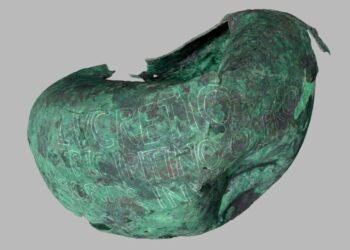Archaeologists have revealed strong evidence that bloody events once occurred in Roman Britain, far from Rome’s great amphitheaters. A recently examined skeleton from York, England, thought to be from the third century CE, displays unmistakable signs of a fatal encounter with a large predatory cat, perhaps a lion. The discovery represents what researchers describe as the first physical evidence of human-animal combat from the Roman era anywhere in Europe.

The skeleton, which belonged to a male aged 26–35 years, was found nearly two decades ago during an archaeological excavation at Driffield Terrace, a burial site near the Roman city of Eboracum, the current city of York. For years, it has been assumed that this burial ground contained gladiator graves since, aside from a high incidence of decapitations, it showed markers in the bone signifying a violent lifestyle and intense physical training.
New research led by Professor Tim Thompson of Maynooth University and published in the journal PLOS ONE confirms that the man had been bitten on his pelvis in a pattern that matched the jaws of a large cat such as a lion, leopard, or tiger. The team, using 3D scanning technology and comparisons with bite patterns from zoo animals, determined that the injuries were most likely inflicted during the man’s final moments.
“The shape is entirely consistent with documented cases of large cat bite,” the team wrote in the paper. They added that the bite marks would not have been directly lethal, but most likely happened as the man was dying or soon after. “It suggests that they were not part of an attack per se, but rather the result of scavenging around the time of death.”

Adding to the mystery, the man had been decapitated—a common feature of most of the 80-plus skeletons found at the site, which range from the first to the fourth century CE. The researchers suggested that beheading might have occurred either to end the man’s suffering or as a display of Roman custom.
What is so remarkable about this find is that physical evidence of gladiator combat with wild animals is very rare, considering the widespread artistic and literary depictions. While mosaics and Roman texts frequently show venationes—bloody spectacles in which humans fought beasts—skeletal remains that indicate such encounters have been virtually non-existent until now.
“This is the first physical evidence for human-animal gladiatorial combat from the Roman period seen anywhere in Europe,” the authors wrote.
Transporting a lion all the way to northern Britain would have been an arduous sea, river, and land journey. According to the study, the creature would most likely have originated from North Africa because there are no native species of big cats in the British Isles.
Whether or not the man was a professional gladiator or a condemned prisoner who was forced to fight is uncertain. But either possibility reflects the brutal conditions of life and death in the Roman arena, even in the farthest corners of the empire, like Britain.






















Not necessarily a gladiator. Could have been a victim for punishment or entertainment.
Where’s the proof?